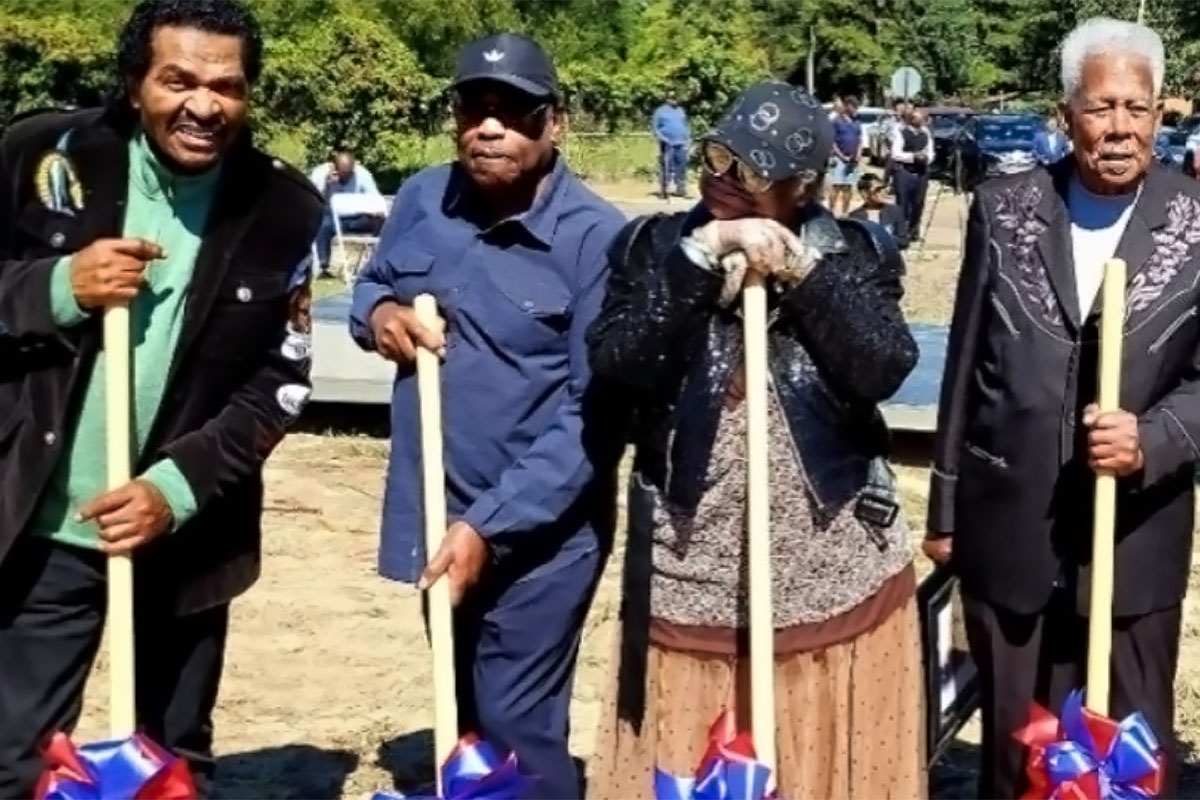As a 5-year-old child, LaMont Robinson stood enthralled during an October 1966 performance as his favorite musician, James Brown, danced on stage, his illustrious hair bouncing to the beat. While performing “Please Please Please,” Brown kneeled as crew members draped a cape over his shoulders.
“When he dropped down on his knee and they put the cape on him, that just had a major effect on me,” Robinson told the Mississippi Free Press.
Nearly three decades later, Robinson met his childhood hero and took a photo with Brown in Augusta, Ga., in 1994. “I love him dearly, and I’m glad I had a chance to let him know that. And I’m friends with his daughters,” he said.
An American professional basketball player and businessman, Robinson founded and presently owns the Harlem Clowns, a team for which he is also a player. His talents have earned him a place in the 2019 American Basketball Hall of Fame.
During a visit to The Rock & Roll Hall of Fame, the basketball player noticed that the 150,000-square-foot facility included information on the effects that R&B had on rock ‘n’roll, but as someone whose parents had instilled in him an appreciation for the genre and its greats such as The Temptations and Aretha Franklin, the Cleveland, Miss., native felt like the museum could have touched more on R&B’s history and cultural legacy.
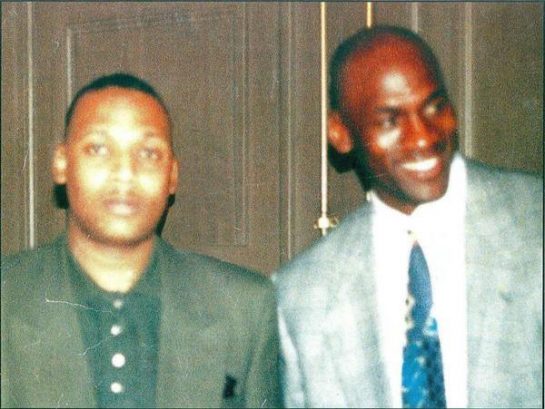
“Rhythm-and-blues music sparked all genres of music outside of the gospel and the blues, and it should have been more recognized,” Robinson said. “That sparked me to take my interest in 2010 and start putting together a rhythm-and-blues hall of fame because country music has one in Nashville, and a rock hall of fame (exists) in Cleveland. Where’s the Rhythm & Blues Hall of Fame at?”
That visit solidified his decision to open the R&B Hall of Fame and turn his vision into a reality. In 2010, he founded the National R&B Hall of Fame, which seeks to educate, preserve and promote rhythm-and-blues music. Robinson copyrighted the National Rhythm & Blues Hall of Fame name in 2014 and has since inducted more than 200 artists such as Whitney Houston, Ray Charles and Barry Gordy. The R&B Hall of Fame also recognizes radio personalities, label owners and other prominent figures in music.
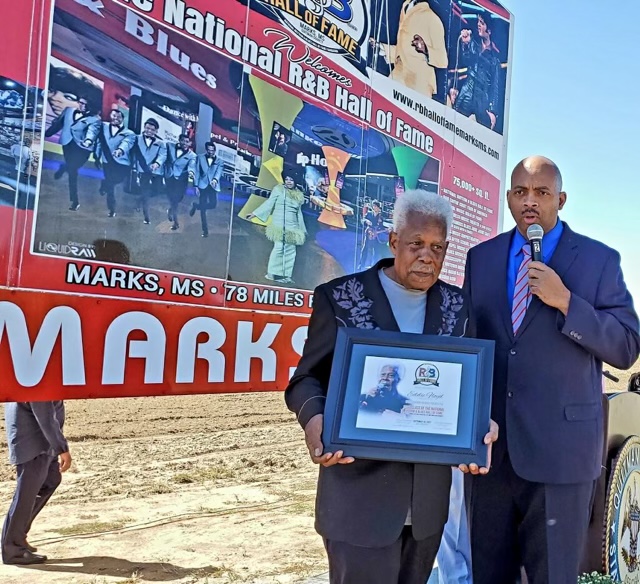
“James Brown, Aretha Franklin and all those people back then that sparked Whitney Houston and Michael and Prince, they also had an effect on rock, country, all those other genres of music, and they don’t get the credit,” Robinson said.
“That’s what sparked me to do that, to give them their credit because a lot of them died poor, sick and homeless,” he added. “Their music is still playing on the radio, but they don’t have a permanent home, and they’ve never gotten the credit that’s due to them.”
Robinson aspires to provide this credit through a physical National Rhythm & Blues Hall of Fame museum, which he plans to build in Marks, Miss., and hopes will be the “Disneyland of Music.” The hall of fame will be a 75,000-square-foot facility that includes a music theater, a cafe, exhibits and other features.
In addition to serving as a tourist attraction that could bring as many as 250,000 tourists to the city, Robinson estimates, the facility should offer more than 100 jobs to the Marks community. The groundbreaking ceremony took place on Friday, Sept. 30, in Marks, located in the Delta region of the state, the birthplace of blues music.
“I like to say gospel and blues had a baby, which was rhythm and blues,” Robinson said. “A lot of the great artists, they all come out of the church. It all comes from blues. A lot of those artists come out of those hollows, come out of the dirt of Mississippi, Alabama and the South. So, it’s like them coming home.”
Music and Civil Rights: ‘Hand-in-Hand’
The athlete and entrepreneur chose to construct the museum in Marks not only due to the town’s location in the Delta region, but also for its connection to the Civil Rights Movement. Marks witnessed the beginning of the Poor People’s Campaign after Martin Lurther King Jr. and Rev. Ralph Abernathy visited what was known then as the poorest town in the country.
“The Poor People’s campaign was born right here in this city,” Rev. John Glaze of New Sardis Baptist Church in Memphis, Tenn., said at the groundbreaking ceremony. “It was born when the Rev. Martin Lurther King Jr. and Rev. Ralph Abernathy wept upon seeing Black school children in this city being served a lunch of a few crackers and one slice of an apple.”
The Poor People’s Campaign led to a demonstration held in Washington, D.C., in 1968, where protesters demanded the government formulate a plan to help fix the employment and housing problems of the poor across the United States.
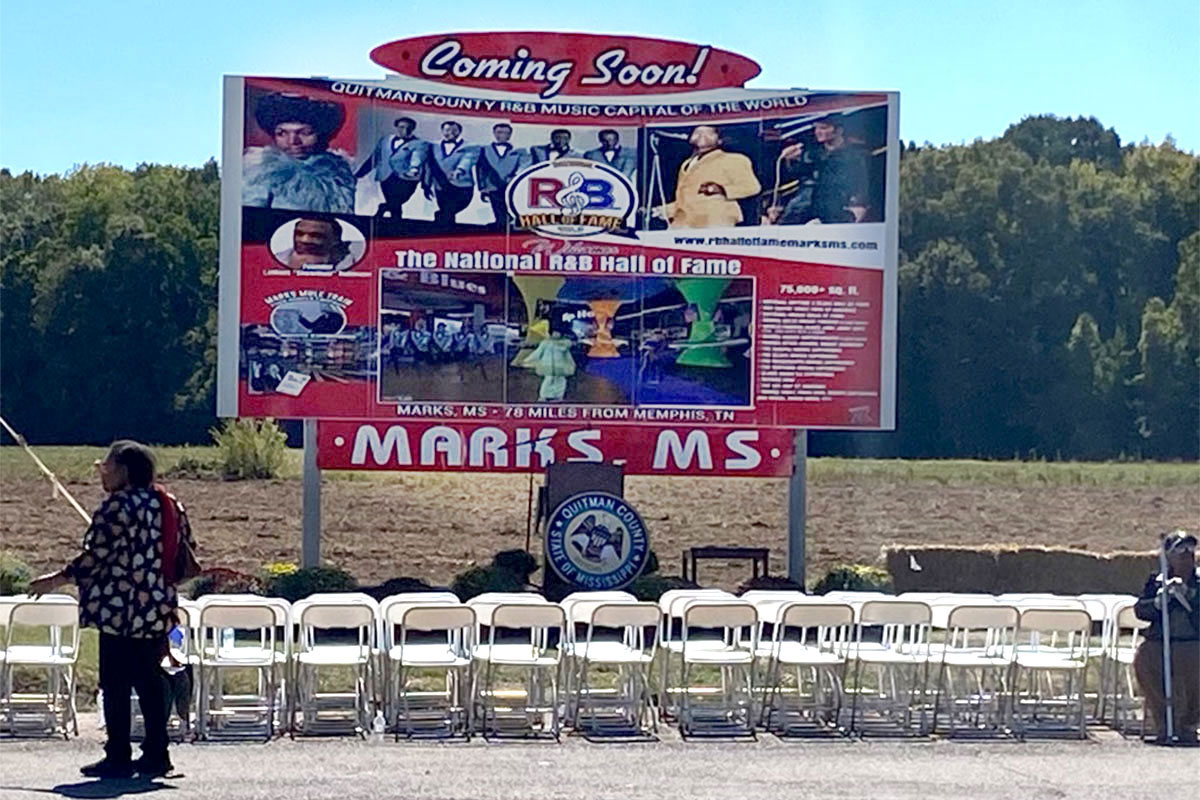
“Music and civil rights went hand-in-hand. If you listen to The Impressions, if you listen to Sam Cooke’s ‘A Change Is Gonna Come,’ all of that was during the Civil Rights Movement around 1964, 1965, 1966,” Robinson said. “King was assassinated in 1968. He came to Marks two weeks before his assassination. I said what better way to honor him and these artists right here in Marks, Miss.”
Robinson and his team want to bring a music-themed five-star hotel to the city, a 21st-century juke-joint restaurant and a theater that seats 1,500 so that musical acts will have a place to perform. He believes Marks can be a tourist city since Mississippi is already a tourist state in many respects.
“It’s gonna be highly interactive, virtual reality, 3D; it will not be your typical museum,” Robinson said of the hall of fame building. “(Many) museums are funeral parlors with lights. That ain’t what we are talking about building. We are talking about building the Disneyland of Music, where you could stand in Woodstock and be with Jimi Hendrix or dance with James Brown or sing with Aretha—just give you that experience.”
The museum will cost around $30 million to build, and the State of Mississippi has already awarded a half-million-dollar grant to the project. Robinson said he is in talks with several companies and a group in Washington, D.C., for additional funding.
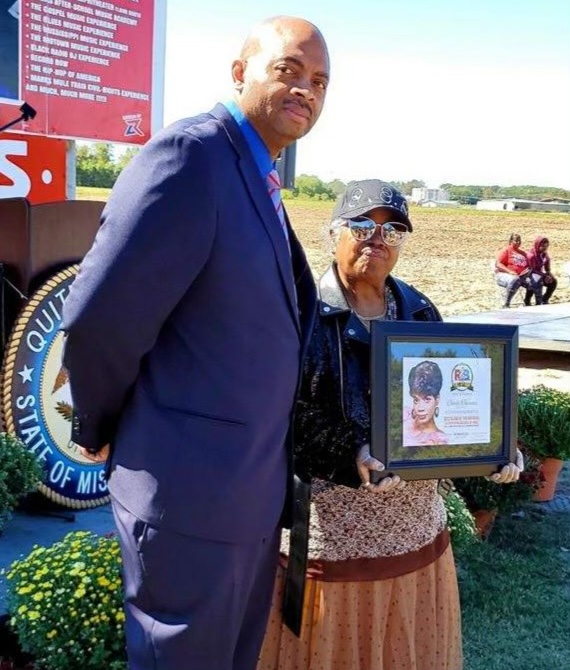
“I have collected over a million dollars worth of memorabilia,” Robinson said. “A lot of it came from being a fan. I took a scrapbook and dreamt of putting four walls around it, which would be the Hall of Fame. I had a lot of friends in the entertainment business. The Temptations gave me a set of suits. The Four Tops gave me a set.”
The Rhythm & Blues Hall of Fame founder said he has always collected programs from shows he attended, including those his grandparents and parents saved. Once the museum opens, he hopes they will be able to partner with other museums to trade memorabilia.
A2H, a company from Oxford, Miss., will design the building, and IMPACT, based in Cleveland, Ohio, will design the exhibit. The R&B Hall of Fame is set to be open by mid-2024, Robinson said.
Blues: ‘The Mother of All Music’
The groundbreaking ceremony also acted as the 2022 ceremony for this year’s group of inductees, which include Al Green, Bobby Rush, Carla Thomas, Eddie Lloyd, Ernest Withers, Johnnie Walker, John Lee Hooker and Willie Mitchell.
Carla Thomas, Bobby Rush and Eddie Lloyd attended the ceremony to receive their certificates as the newest additions to the Hall of Fame.
Bobby Rush was born Emmett Ellis Jr. outside Homer, La., in 1933. He learned to twang a diddley bow before he picked up a guitar at age 11. His father, a preacher, knew enough about the harmonica to pass on a few skills to his son as well.
The Ellis family moved to Pine Bluff, Ark., in 1948. While a teenager, Bobby Rush became a professional blues musician, adopting his Rush moniker for his stage persona so that he would not inadvertently disrespect his father’s name. Rush would fashion a mustache out of matchstick ash to sneak into clubs and juke joints.
In Pine Bluff, Ark., Rush met guitarist Elmore James and played around the Deep South with him and harmonica ace, Little Walter. Through those travels, Rush met other blues greats like Howlin’ Wolf and Muddy Waters.
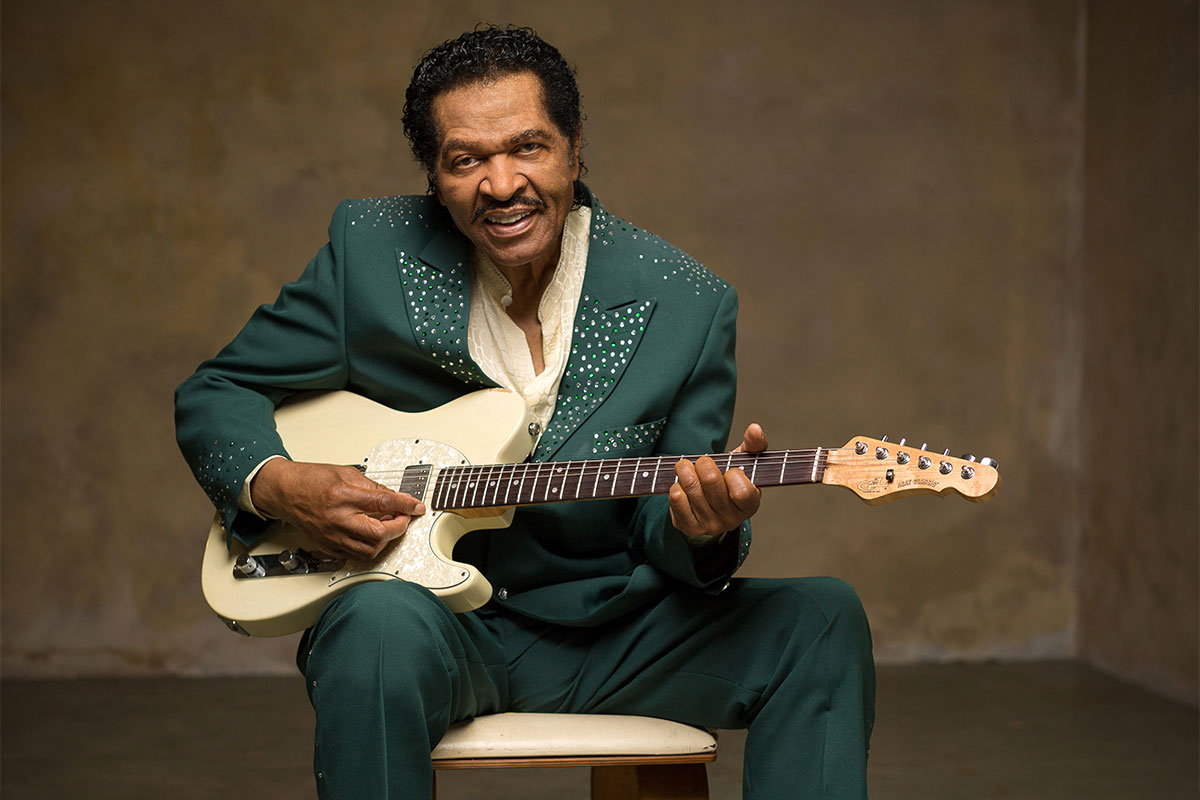
In 1951, Rush moved to Chicago to engage in the city’s booming blues scene. He assembled a band with Freddie King on guitar and Luther Allison later joining the group. In 1964, he made his recording debut with “Someday” on the Jerry-O label. The artist’s recording of “Sock Boo Ga Loo” propelled him into the big leagues of R&B, and in 1971, he broke through on national charts with “Chicken Heads.”
Rush is a two-time Grammy winner, a Blues Hall of Famer, a six-time Grammy nominee and a 14-time Blues Music Award winner. “Blues, it’s the mother of all music. If you don’t like the blues, you probably don’t like your mama,” Rush said during his acceptance speech.
Carla Thomas, known as the Queen of Memphis Soul, grew up a few blocks from Beale Street, where her father and musician Rufus Thomas worked as an emcee at the Palace Theater, which became a world-famous blues-talent showcase. She would go with her father to the Palace, where she developed her musical styling as she listened to blues performances from Bobby Bland to B.B. King.
At age 10, Carla joined WDIA’s Radio’s Teen Town Singers, even though 14 was the official age requirement. Carla stayed with the group until her senior year in high school. At 16, she wrote “Gee Whiz (Look at His Eyes),” which propelled her into the international spotlight. The tune became her signature song and reached Top 10 on the pop chart and Top 5 on the R&B chart. The song’s success led her to perform on American Bandstand.
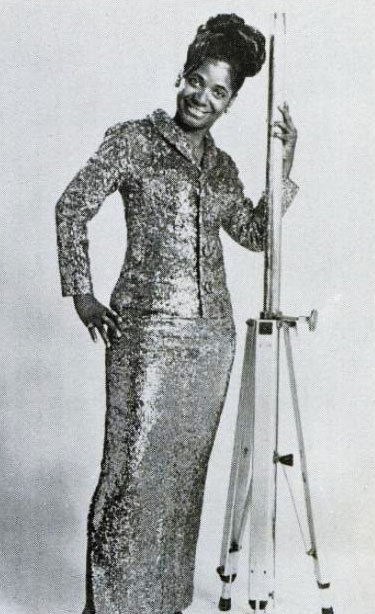
Carla’s songs hit the national charts more than 20 times with singles like “Let Me Be Good to You,” “I Like What You’re Doing to Me,” “I’ve Got No Time to Lose,” “A Love of My Own” and more. In between recording and performing, Thomas found time to obtain her undergraduate degree from Tennessee State University and subsequently continued her studies at Howard University with classmates such as Roberta Flack, Donny Hathaway and Harold Wheeler.
“If you have a dream, if you have a gift, if you have a talent, the first thing you have to recognize is that God gave it to you,” Thomas told the audience at the hall of fame ceremony. “When you have a gift, you really should take care of that gift.”
Eddie Floyd kept his acceptance brief, opting to sing one of his hits, “Knock On Wood,” in lieu of giving a speech. Floyd was born in Montgomery, Ala., in 1937, but grew up in Detroit, Mich., where his uncle Robert West owned the Lu Pine and Flick record labels, two early competitors to the Motown label.
There, Floyd co-founded the Falcons, an R&B vocal group that preceded other Detroit groups like The Temptations and The Four Tops. The group later added future soul legends like Mack Rise and Wilson Pickett alongside Floyd. In 1959, the group scored a Top 20 pop hit with “You’re So Fine,” giving Floyd his first taste of national success. The group scored another hit three years later with “I Found a Love.”
The group disbanded in 1963, and Floyd relocated to Washington, D.C., where he co-founded the label, Safice, with then-DJ Al Bell. Bell received an offer from Stax label in Memphis, Tenn., to take a job opportunity with them, and Floyd followed him.
At Stax, Floyd felt at home as a songwriter and producer. He began to form a relationship with Booker T. and M.G.’s guitarist, Steve Cropper, who became his de-facto songwriting partner over the years. Floyd began recording as a solo artist, and that summer, he and Cropper began working on music that ultimately launched Floyd into soul music stardom.
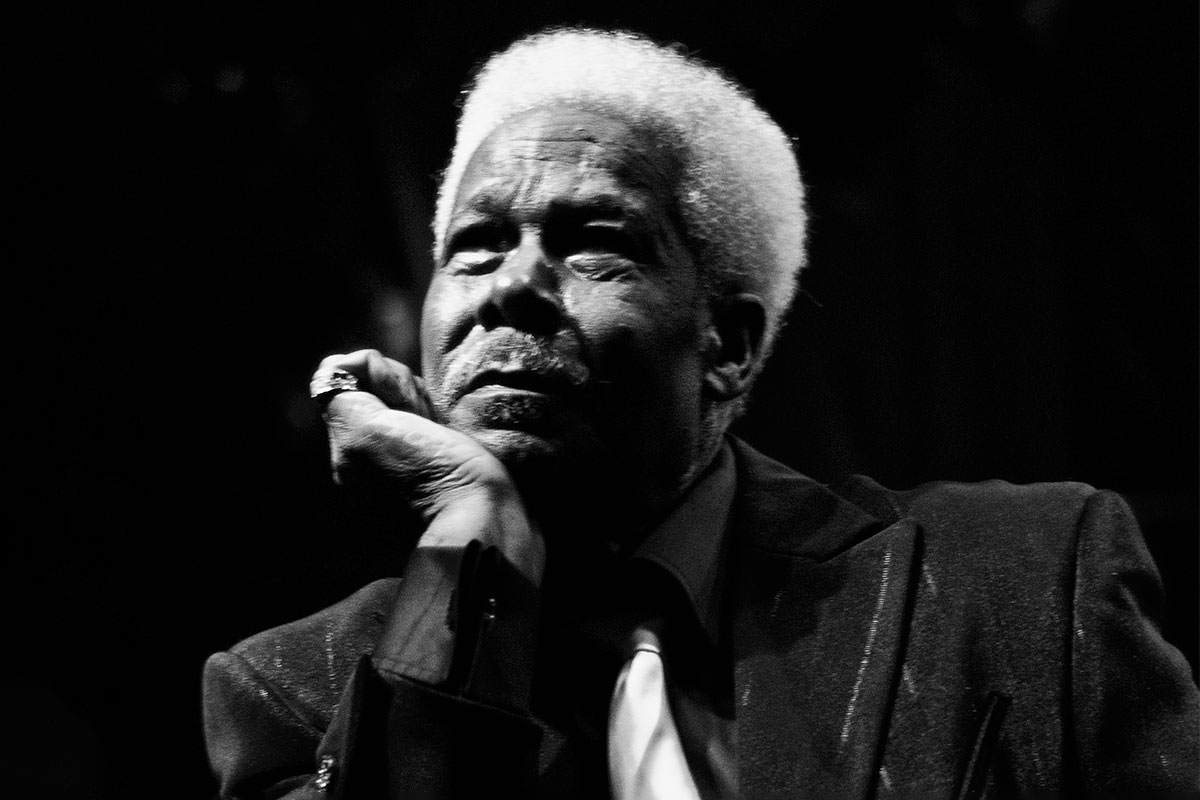
Floyd’s demo version of “Knock on Wood” became the label’s third number-one R&B hit of the year, a song that was originally intended for Otis Redding. Over the next four years, he would follow up his success with a string of other Top 40 hits including “Raise Your Hand,” “On Saturday Night” and “I’ve Never Found a Girl (To Love Me Like You Do).”
2022 R&B Hall of Fame Inductees
Albert “Al” Green was born on April 13, 1946, in Forrest City, Ark. In 1964, his family moved from Arkansas to Michigan, where he and some friends formed The Creations and toured the Chitlin’ Circuit in the South. Three years later, the group renamed themselves Al Green and the Soul Mates. The group formed their own record label and released “Back Up Train,” which saw moderate success on the R&B charts in 1968.
In Texas that same year, Green met Willie Mitchell, a former bandleader who served as chief producer and vice president for Hi Records in Memphis, Tenn. Mitchell and Green began working together, and Green released a cover of the Beatles’ “I Want to Hold Your Hand” in 1969, soon after also recording a remake of the Temptations’ “I Can’t Get Next to You,” which reached number one on the soul charts in 1971.
Green’s original song “Tired of Being Alone” sold more than 1 million copies, preparing the way for “Let’s Stay Together,” the titular track from his first gold album. “Let’s Stay Together” was his biggest hit, reaching number one on R&B and pop charts in 1972. Green and Mitchell experienced a string of additional hits through the early 1970s.
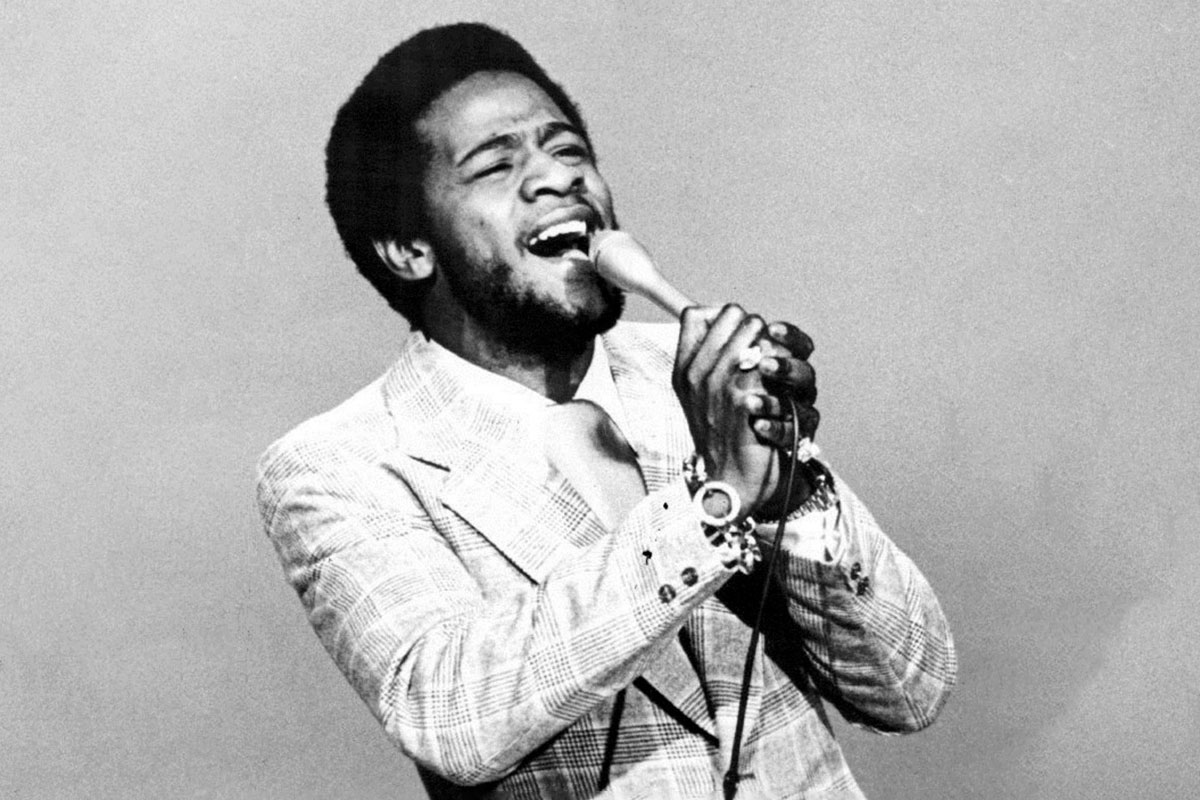
“King of Sophisticated Funk” Willie Mitchell was born in Ashland, Miss., and was a toddler when his family moved to Memphis. At only 8 years old, he started playing trumpet, and in his early teens, he performed as a featured player in local bands that Al Jackson Sr. and Tuff Green led. After being discharged from the U.S. Army in 1954, he led a group at the Manhattan Club and later took over the house band at the Plantation Inn in West Memphis.
Mitchell played band gigs on Beale Street as he developed his leadership skills and learned the finer points of showmanship, arranging, management and other crafts that proved useful in the music scene. He knew every musician in town and observed crowds from the bandstand every night to learn what people wanted to hear and what compelled them to dance.These qualifications made Mitchell an ideal session leader for Joe Cuoghi’s Hi Records. Mitchell was busy for much of the 1960s as a bandleader in clubs and as a session leader, musician and arranger at the label. He reached No. 31 on the national pop charts in 1964 with “20-75.” Mitchell’s crossover hit “Soul Serenade” put the Willie Mitchell Band on the road.
Al Green, who signed to Hi Records, opened for Mitchell’s band in Midland, Texas, further solidifying their partnership.
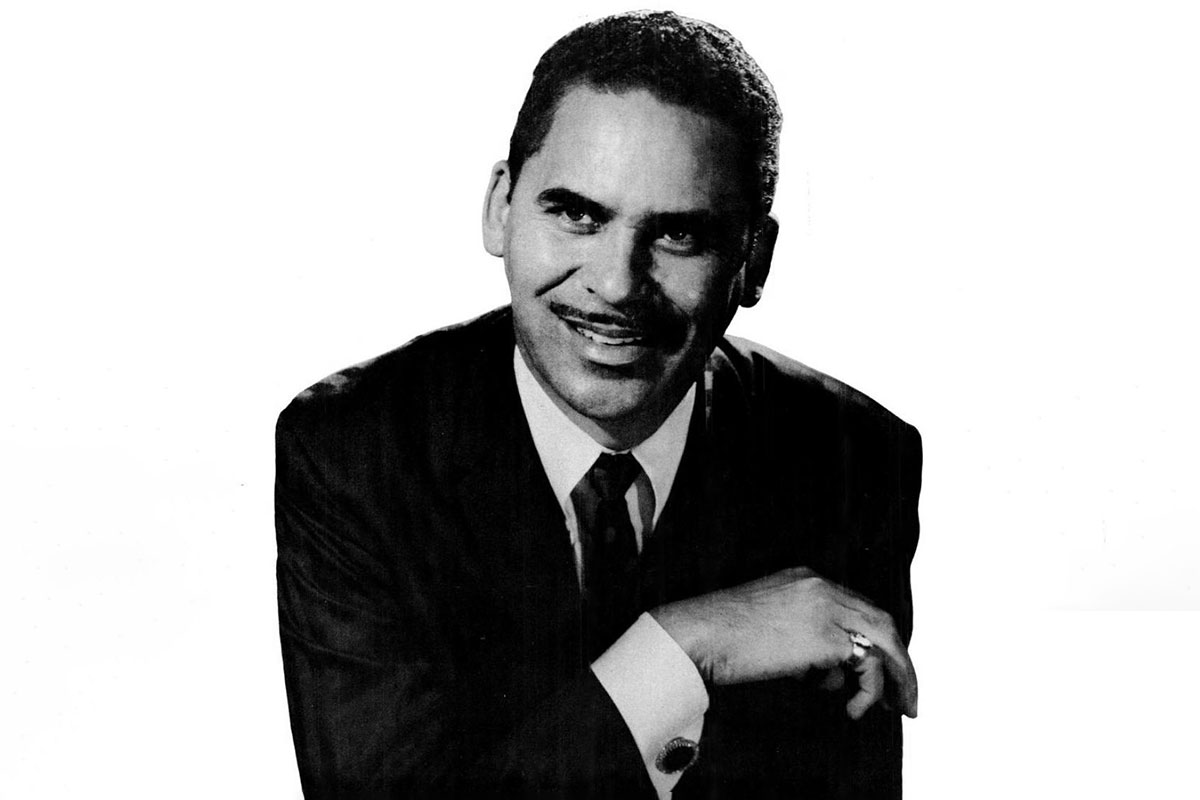
Born into a Mississippi sharecropping family, John Lee Hooker learned to play the guitar from his stepfather and developed an interest in gospel music as a child. In 1943, he moved to Detroit, Mich., where he made his mark as a blues musician. He was a primitive guitarist who played simple harmonies, pentatonic scales, and one-chord, modal harmonic structures.
He toured widely from the 1950s and appeared in films like “The Blues Brothers” and “The Color Purple.” His music influenced bands like The Rolling Stones and The Animals, earning him recognition in the Rock & Roll Hall of Fame in 1991. Hooker recorded more than 100 albums, with “Don’t Look Back” winning a Grammy for Best Traditional Blues Album.
Ernest Withers and Johnnie Walker
Ernest Withers was born on Aug. 7, 1922, in Memphis, Tenn. Withers got his start as a military photographer while serving in the South Pacific during World War II. After returning to Memphis, he chose photography as his profession. In the 1950s, he helped spur the movement for equal rights with a self-published photo pamphlet on Emmitt Till’s murder.
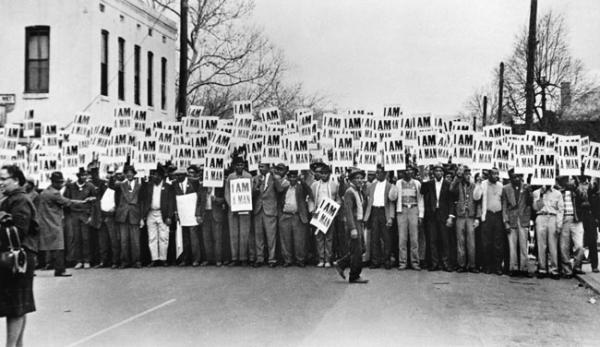
Over the next two decades, he formed close relationships with Dr. Martin Luther King Jr., Medgar Evers and James Meredith. He took photos of key civil-rights events from the Montgomery Bus Boycott to the strike of the Memphis sanitation workers. He was often the only photographer to record these scenes, many of which did not garner the interest of the mainstream press.
He also photographed early performances of Elvis Presley, B.B. King, Ike and Tina Turner, Ray Charles and Aretha Franklin. In his more-than-60-year career, Withers accumulated a collection of an estimated 5 million photographs. His works have appeared in The New York Times, Jet, Ebony, Newsweek and Life.
Grenada, Miss. native Johnnie Walker began her career as a country music radio personality in her hometown and she later segued to black radio as an announcer and program director. In 1989, she joined Def Jam Recordings as a regional marketing representative and within one year, she was promoted to National Director of Promotion. That position was short-lived as she was promptly promoted to Senior National Director, where she was largely responsible for the careers of Ludacris, Method Man, Kelly Price, Montel Jordan, DMX, Ja Rule, Public Enemy and LL Cool J.
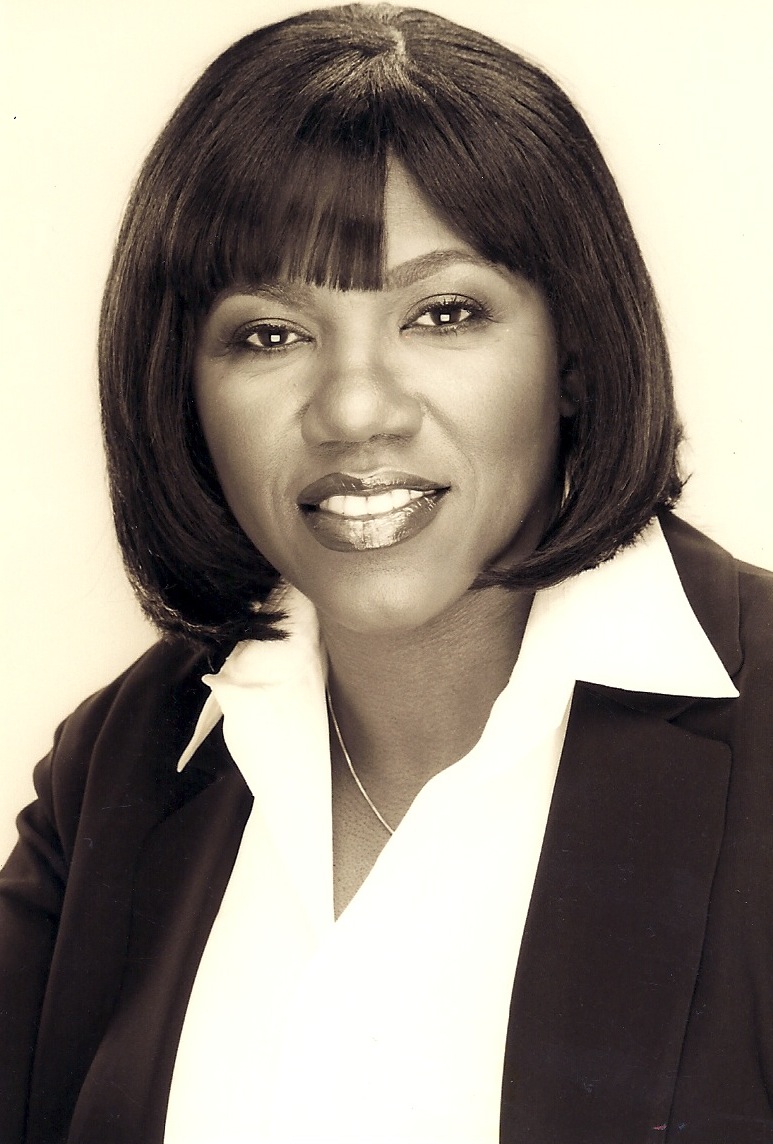
At the direction of Russell Simmons, Walker relocated to New York City in 1997 and became vice president of promotion for Def Jam. A year later, after restructuring the company’s promotions department and its field staff, she became senior vice president. During her tenure, her team successfully marketed “Def Comedy Jam”; “Phat Farm” clothing; Russell Simmons’ co-produced movies, “The Nutty Professor,” “The Klumps,”Jackie Chan’s “Rush Hour 1 and 2”; and several #1 gold and platinum albums.
After 15 years, Walker moved to Los Angeles and assumed the position of Head of Black Music for DreamWorks Records. Following the sale of the label, she headed to Memphis to take the helm of the Memphis Music Commission, where she spearheaded a wealth of culturally diverse music programs and creative initiatives.
In 1999, she created the National Association of Black Female Executives in Music and Entertainment (NABFEME), but it wasn’t officially incorporated until 2000. The organization grew quickly with sites in Los Angeles, Chicago, New York, Detroit, Nashville, Washington, D.C., and Atlanta with operating hubs in Canada and Africa. Walker recently joined the Music Industry Relations Collective, an advisory board of the National Museum of African American Music located in Nashville, Tenn.

